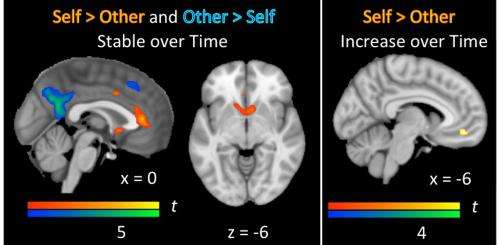Brain biology tied to social reorientation during entry to adolescence

A specific region of the brain is in play when children consider their identity and social status as they transition into adolescence—that often-turbulent time of reaching puberty and entering middle school, says a University of Oregon psychologist.
In a study of 27 neurologically typical children who underwent functional magnetic resonance imaging (fMRI) at ages 10 and 13, activity in the brain's ventromedial prefrontal cortex increased dramatically when the subjects responded to questions about how they view themselves.
The findings, published in the April 24 issue of the Journal of Neuroscience, confirm previous findings that specific brain networks support self-evaluations in the growing brain, but, more importantly, provide evidence that basic biology may well drive some of these changes, says Jennifer H. Pfeifer, professor of psychology and director of the psychology department's Developmental Social Neuroscience Lab.
"This is a longitudinal fMRI study, which is still relatively uncommon," Pfeifer said. "It suggests a link between neural responses during self-evaluative processing in the social domain, and pubertal development. This provides a rare piece of empirical evidence in humans, rather than animal models, that supports the common theory that adolescents are biologically driven to go through a social reorientation."
Participants were scanned for about seven minutes at each visit. They responded to a series of attributes tied to social or academic domains—social ones such as "I am popular" or "I wish I had more friends" and academic ones such as "I like to read just for fun" or "Writing is so boring." Social and academic evaluations were made about both the self and a familiar fictional character, Harry Potter.
In previous research, Pfeifer had found that a more dorsal region of the medial prefrontal cortex was more responsive in 10-year-old children during self-evaluations, when they were compared to adults. The new study, she said, provides a more detailed picture of how the brain supports self-development by looking at change within individuals.
The fMRI analyses found it was primarily the social self-evaluations that triggered significant increases over time in blood-oxygen levels, which fMRI detects, in the ventral medial prefrontal cortex. Additionally, these increases were strongest in children who experienced the most pubertal development over the three-year study period, for both girls and boys. Increases during academic self-evaluations were at best marginal. Whole-brain analyses found no other areas of the brain had significant increases or decreases in activity related to pubertal development.
"Neural changes in the social domain were more robust," Pfeifer said. "Increased responses in this one region of the brain from age 10 to 13 were very evident in social self-evaluations, but not academic ones. This pattern is consistent with the enormous importance that most children entering adolescence place on their peer relationships and social status, compared to the relatively diminished value often associated with academics during this transition."
In youth with autism spectrum disorders, this specialized response in ventral medial prefrontal cortex is missing, she added, citing a paper she co-authored in the February 2013 issue of the Journal of Autism and Developmental Disorders and a complementary study led by Michael V. Lombardo, University of Cambridge, in the February 2010 issue of the journal Brain. The absence of this typical effect, Pfeifer said, might be related to the challenges these individuals often face in both self-understanding and social relations.
"Dr. Pfeifer's research examining self-evaluations during adolescence adds significantly to the intricate puzzle of this turbulent age period," said Kimberly Andrews Espy, vice president for research and innovation and dean of the graduate school. "Researchers at the University of Oregon are piecing together how both biology and the environment dynamically and interactively support healthy social development."
















